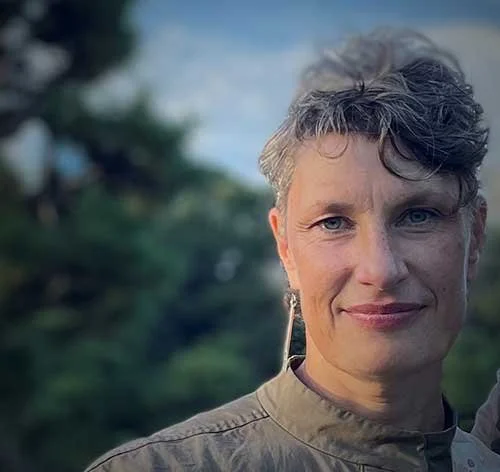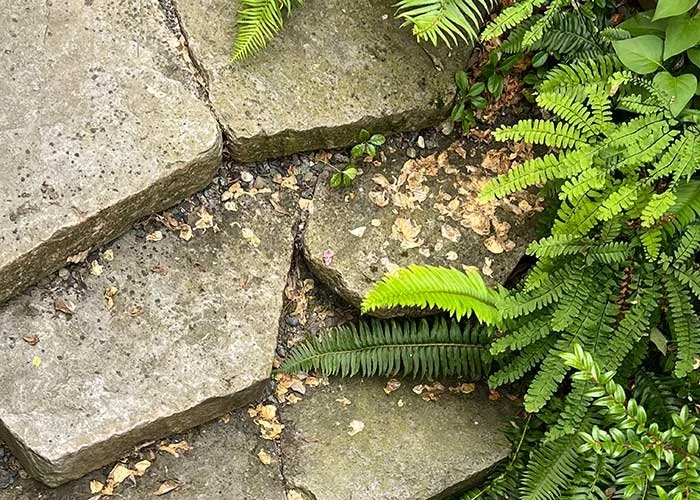Featured Designer | Sarah Van Sanden
January 2024
Owner and Designer at SVS Landscape Design
Sarah Van Sanden, owner and lead designer of SVS Landscape Design; Photo: Natalya Lopez De La Cruz
When did you start designing gardens?
Landscape and gardens have always been a big part of my life, but my path to designing them has been a bit circuitous. My parents are both plant-obsessed and my mom had a landscaping business that infused our home life as I was growing up. I studied ethnobotany and visual art in college, but didn’t decide to become a designer until 2005, when I went to graduate school for Landscape Architecture.
Even then, it took years of doing CAD drafting and urban planning projects in an architecture firm and then working as a crew lead (and occasionally as a designer) in a landscape design/build/maintain company, before I took the leap to start my own company in 2019 with a focus on design work.
The past four years have been like drinking from a fire hose, learning an incredible amount as I go while also finding my experiences and knowledge engaged in useful ways.
How would you describe your design style?
Informal, humane, ecologically-attuned, practical, and hopeful.
Photo: Sarah Van Sanden; Installation By: Van Sanden Landscaping Inc.
Who inspires you and your designs?
Terremoto, John Little, Shirley Watts, Rebecca McMackin and her work with Brooklyn Bridge Park, home and community gardeners everywhere and Mother Nature.
Is your focus design? Or do you also manage installation, build, and maintain gardens?
I focus on design and am typically involved in a consulting capacity through installation. I have over a decade of landscape installation and maintenance experience, and that heavily influences how I design landscapes. That experience also instills in me an immense respect for contractors who build on these designs.
What experiences as a designer have you found to be the most challenging?
When I first started designing, I felt I needed to put forward a confidence that I had it all under control. The projects where I didn’t have the courage to reach out to ask for help (whether that’s asking Kryssie Maybay for grading help, asking Laura Kleppe or Tom Lawson for ECA advice, or getting LandFX questions answered by Joanna D’Asaro) have been the most challenging.
The other thing that can dog a project for me is not having good communication with the client. I’m learning to listen earlier for that and steer away when it’s not a good fit.
What experiences have you found to be the most rewarding?
I’m most in my element when I get to apply non-traditional forms and concepts to practical use.
I absolutely love collaborating with Jim Honold on custom metal work, for example. We created a project with a steel retaining wall and outdoor shower based on a series of arcs and another with a fun fire feature.
Urban Sanctuary with steel wall and outdoor shower designed to coordinate with cedar sauna from a kit (right). Design: Sarah Van Sanden and Jim Honold (metalwork); Photo: Sarah Van Sanden; Installation: Van Sanden Landscaping Inc. and Mod Studio
Blue Ridge Terrace. Design: Sarah Van Sanden and Jim Honold (metalwork); Photo: Sarah Van Sanden; Installation: Van Sanden Landscaping Inc. and Mod Studio
I designed a small garden in San Francisco around a collection of fabric bags made by the client’s late husband that we coated with sculpting polymer and used as hanging planters. The beauty and joyful memorial quality of the space was immensely gratifying.
Planted fabric bags in San Francisco Garden. Design: Sarah Van Sanden; Photo: Sarah Van Sanden; Fabric bags: Jacob Alexander; Landscape installation: Down To Earth Landscapes
San Francisco Garden. Design: Sarah Van Sanden; Photo: Sarah Van Sanden; Fabric bags: Jacob Alexander; Landscape installation: Down To Earth Landscapes
How has permitting requirements (stormwater, ECA, etc.) or site limitations affected your design process and creativity?
There’s nothing more daunting than a blank slate. Challenges and limitations are often the starting points for interesting designs and really force me to think creatively. Of course, this means starting with thorough jurisdictional property research, detailed measurements and observations on site, but often this process of discovery is where creative ideas start to bubble up to the surface. The seemingly dry process of figuring out where you can locate clients’ desires in accordance with codes can suggest forms and rhythms that are more interesting and appropriate than an idea plucked from Houzz and plopped onto a site.
Often the most interesting and unique things about a site are the things that limit its use. For us in the Pacific Northwest that typically means hydrology and slopes. My best designs are those that honor or even play up the inherent qualities of a site, so I appreciate it when the codes nudge us toward leaving slopes unterraced, keeping existing trees and using native plants.
In defense of slopes. Design: Sarah Van Sanden and Jim Honold (metalwork); Photo: Sarah Van Sanden; Installation: Van Sanden Landscaping Inc. and Mod Studio
What would your ideal project and client be?
I love working with clients who have a sense of curiosity and humility about their landscape and a willingness to let existing features and context inform the design. It helps if they intend to stay in place for a bit and to watch their garden grow and change over time. Extra bonus if they come with the understanding of gardens as places of process and change (including death and decay) and an allowance for there to always be unfolding and discovery. My ideal projects are in urban settings, incorporate some non-human habitat, look outside the property boundary for connection, and always allow a bit of quirk.
North Seattle Garden. Design: Sarah Van Sanden; Photo: Sarah Van Sanden; Installation: NW Bloom
Do you collaborate with other designers?
I have designed two projects with Naomi Goodman of Firecracker Design Studio and am collaborating now on a project with Kryssie Maybay of Kismet Design. The extra work involved in collaborating can be painful at times since I’m so accustomed to working alone, but it’s a fantastic way to get exposure to other folks’ process, practice flexibility and openness, and tap into the amazing wealth of knowledge, experience and creativity of our colleagues. Even when I’m not officially collaborating, I often ask colleagues for advice and design critiques.
Kiddo play path between cedars (design collaboration with Firecracker Design Studio). Design: Sarah Van Sanden and Naomi Goodman; Photo: Sarah Van Sanden; Installation: Sage and Stone LLC
What changes would you like to see in the green industry as a whole? How do your talents or your approach to design support the change you envision?
Hmm, even calling it the green industry is ironic, I think. We are so much in the business of un-greening the world. I want to see us get more focused on the social and ecological impact of each of the projects we work on. We should be approaching each site with the intent to maximize preservation and re-use or repurposing of existing landscape elements and materials; choosing plant palettes that require less water, fertilizer, herbicides, pesticides and mulch; and thinking about the life cycle of our hardscapes—from inputs required for construction and maintenance to whether or not it is destined for landfill later.
We need to take seriously our role in educating clients about these imperatives, too. I understand that these are huge existential hurdles for our industry and individual livelihoods. There are no financial incentives to do smaller interventions or sell clients less stuff, especially when products are more profitable than labor. We have to be really creative about our business strategies to make these changes.
In terms of what I bring to the table, I think my sensitivity to site and context and my interest in atypical design solutions open up more opportunities for design that is respectful, resilient and regenerative. My knowledge and love of PNW native plants comes in handy, too. I also think it helps that I take time with clients to ask good questions, listen carefully, and communicate ways that a design can align with their values and what brings them joy without looking like the Pinterest Boards they bring to an initial meeting. This requires time, trust and compassion.
Squash volunteer in recently installed gravel garden. Design: Sarah Van Sanden; Photo: Sarah Van Sanden; Installation: Van Sanden Landscaping
I still have so much to learn, though, and this is where continuing to investigate new ideas, learn from the past, ask hard questions, experiment, and look at the work of others, is crucial. No one person can know everything, so I constantly remind myself to reach out to the knowledge and expertise of others.
West Seattle Patio. Design: Sarah Van Sanden; Photo: Sarah Van Sanden; Installation: In Harmony Sustainable Landscapes
Sarah Van Sanden
SVS Landscape Design
svslandscapedesign.com
instagram.com/svslandscape











